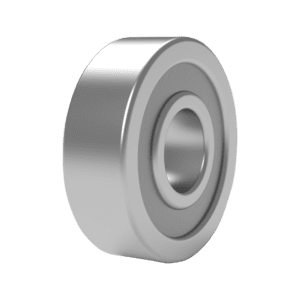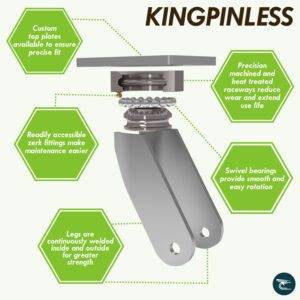

High-temp casters are essential for high-temperature environments, such as a high-temp oven or autoclave. It is crucial to take the necessary precautions to ensure your equipment can handle the heat. Elevated temperatures can significantly impact the performance and longevity of your casters, and failing to address this issue could result in costly equipment failure or downtime.
For this reason, Caster Concepts has expanded our product offering of Casters and Wheels with pre-engineered solutions for high-temperature applications.
One primary consideration for high temperature casters is the high temperature grease used. Standard low-temperature grease works fine for temperatures up to around 150 degrees Fahrenheit. At higher temperatures, it will start to liquefy and run out of the wheels and swivel sections.
This can lead to increased friction in the wheel and swivel section bearings. This increased friction increases wear and reduces the life of the bearing components, which reduces the life of the industrial caster.
To avoid this, switch to a high temp grease that can withstand elevated temperatures, such as Superlube® high temp grease. This type of grease is specially formulated to maintain its viscosity and lubrication properties at high temperatures, making it an essential component of any caster used in elevated-temperature environments.
RELATED: Choosing High-Temperature Casters – Top 5 Factors to Consider.

Precision Ball Bearing
Another important consideration for high-temperature applications is the caster wheel bearings. As materials heat up, they expand, so you must ensure that your bearings have the proper clearances to accommodate this expansion.
Bearings with looser clearances are available for elevated temperatures, including precision ball bearings and tapered roller bearings. A standard roller bearing may be suitable for even higher temperatures but is not ideal for towing applications. Most standard ball bearings are rated for applications below 300° F, while a bronze sleeve bearing can operate in temperatures ranging from 600° —700° F but decreases the caster’s rollability.
In addition to bearing clearances, swivel section design is also an important consideration. A maintenance-free line is not recommended for elevated temperatures, as the sealed bearings will lose their effectiveness once the grease liquefies.
Instead, you should choose a caster that requires maintenance, such as a kingpinless design with enough internal clearances to allow for expansion. The kingpinless design can easily be regreased with high-temperature grease. A standard kingpin design with ball bearings may also be suitable, as long as the tapered bearings used as the secondary thrust load bearing element have the proper clearances.
 The effect of high heat on materials.
The effect of high heat on materials.For extreme temperature applications above 600 degrees Fahrenheit, the caster design should be carefully considered to ensure it can handle the required load capacity. At 1100 degrees, steel is reduced to around 50% strength, so it’s crucial to choose a caster with sufficient load capacity for the task at hand.
It’s also important to consider the materials used in the caster construction, as some materials may not withstand extreme temperatures. Stainless steel is often a good choice for high-temperature applications, as it can withstand temperatures up to around 1400 degrees Fahrenheit.
| WHEEL MATERIAL | 0-250° | 350°-RANGE |
| CAST IRON | CAST IRON | |
| STEEL | STEEL | |
| HIGH-TEMP PHENOLIC | HIGH-TEMP PHENOLIC | |
| STANDARD PHENOLIC | NYLON | |
| MC901-HEAT STABILIZED CAST NYLON |
In summary, moving casters into an oven or other elevated temperature environment requires careful consideration of several factors:
1. Temperature range—Be sure to choose a caster rated for the maximum temperature it will be exposed to.
2. Load capacity – Ensure that your caster can handle the weight of your equipment and any additional loads that may be added during use.
3. Design – Choose a caster with a swivel section and wheel bearings specifically designed for high-temperature applications.
Finally, choose a high-quality, reliable caster from a trusted supplier to ensure that your equipment performs optimally for years to come. By considering factors such as high temperature grease, bearing clearances, caster design, and load capacity, you can ensure that your equipment performs reliably and efficiently, even in the most challenging conditions.